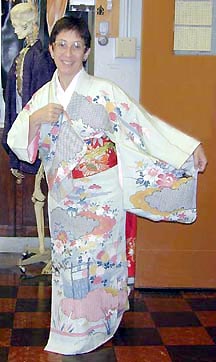U.S. - Japan
Internet Collaboration
How
it works:
The Japanese-government-sponsored Fulbright
Memorial Fund Teachers Program enables teachers to visit Japan
and learn about its culture and educational system. Participants
are then eligible to have their
school join the Master Teacher Program, which matches U.S. and Japanese
schools for a year-long collaboration. Collaborative
projects are based on the theme of biodiversity and the study of the
environment. In-person teacher visits to the partner schools are followed by joint activities and Internet communications.
The project
components include the week-long visit of the principal and two teachers from
the Japanese school partner to the U.S. school in March ( the Japanese
school year begins April 1, so the collaboration year follows that
calendar); the month-long visit of a U.S. teacher to the Japanese school
for a month during the summer; the "BUGS" project
collaboration in which students at all 42 Japanese and American
schools go outside in the Fall to find out what insects
and other arthropods live near them; and an online "daily
communication" between U.S. and Japanese students that continues
for several months. Every day, one student from each school records the weather and
sends a brief message in English along with a digital picture. These
messages are entered into a Microsoft Excel worksheet that is then
saved as a web page and posted on the respective school websites.
During International Education Week, an International "video
lesson" is conducted between classes in the two schools in which the two teachers each
conduct part of the lesson and the students participate in the same hands-on science activity and
report their
results to one another.
Standards addressed:
This is an integrated studies activity that fulfills standards of
science inquiry, understanding of the diversity of life and
environmental studies, the use of technology, and international education.
.
Materials used:
Materials include computers with Internet access for the video
conferences, insect collecting and identification materials,
stereoscopes and the Intel "Play" digital microscope for
taking pictures of the insects, a digital camera and computer camera,
a microphone, a digital projector, and a video camera to record activities.
The
students:
Mott Hall is a science, math, and technology magnet school for
Community School District 6, which serves the North Harlem-Washington
Heights neighborhood of Manhattan. It enrolls 450 students in grades
four through eight. Seventh grade students participated in this project.
Approximately 85 percent of the student population are first- or second-
generation immigrants from Latin American, especially the Dominican
Republic. Approximately 10% are African Americans. The others are almost all immigrants from other
countries. More than 60% of the students are girls.
Overall value:
Internet-based collaboration projects between classes from
different backgrounds are win-win activities. Working on projects
together breaks down barriers and helps students to see how they are
similar to people living in different places as well as having
interesting differences. Students are motivated to do a good job on
their projects, knowing they will have to report on their results to others. The
power of technology to connect students with the rest of the world is demonstrated by this U.S.-Japan Internet Collaboration.
Tips:
Before starting your class on an Internet-based collaboration, take
some time for the teachers to communicate and get to know one another.
Explain your time and curriculum and equipment limitations to each
other. Don't be too much of a perfectionist -- put the spirit of friendship and collaboration foremost.
|

About the teacher:
Susan Herzog is a middle school science teacher at the Mott Hall
School-IS223. In addition to teaching seventh grade life science, Susan is
the Director of Mott Hall-CCNY STARS (Student Apprenticeships In
Research), a collaboration between the two schools in which eighth grade students
spend three hours a week working with mentors in CCNY Science
and Engineering Research laboratories. She has a bachelor's degree
and a master's in secondary science teaching from the City College of the
City University of New York. She entered teaching as a second
career at age 48, has been teaching for nine years, and is a pioneer in the use of the Internet in her
school.
E-mail: sherzog@hotmail.com
Subject
Areas:
Science
Technology
Grade
Levels:
7-8
|